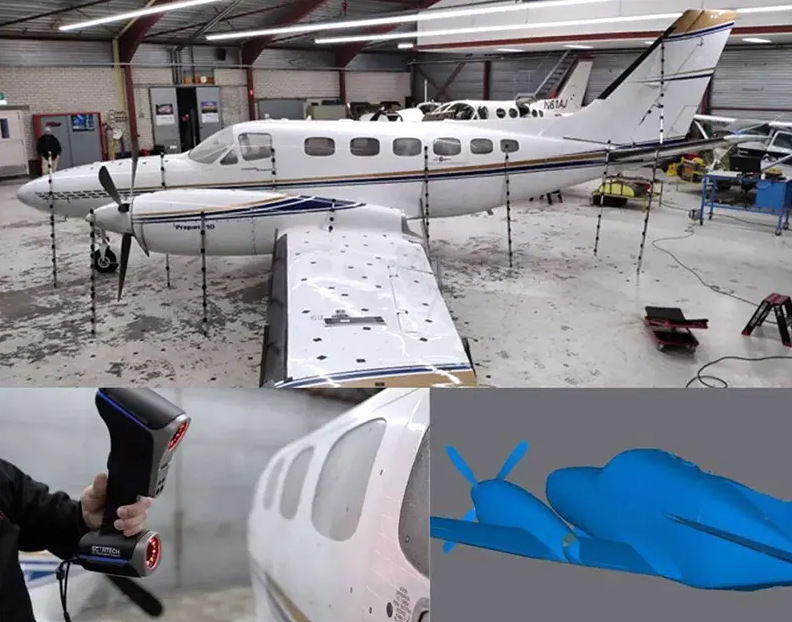In the global aviation industry, precision and efficiency are critical to achieving excellence in aircraft manufacturing and maintenance.
As the demand for advanced aviation technologies grows, the ability to streamline design, production, and maintenance processes is more important than ever.
SCANTECH is leading the way by providing advanced 3D scanning solutions that address the most complex challenges faced by aviation manufacturers.
From optimizing design cycles and ensuring precise manufacturing to enabling accurate virtual assembly and non-destructive testing, SCANTECH’s technology helps aviation companies meet rigorous industry standards.
By offering unparalleled accuracy and speed, SCANTECH’s 3D scanning systems empower engineers and manufacturers to maintain high-quality standards, reduce waste, and improve overall operational efficiency.
With a strong presence in the global aviation market, SCANTECH’s solutions have been successfully integrated into the operations of leading aviation companies.
Our technology supports critical processes, such as product development, precision inspection, and proactive maintenance, driving the future of the aviation industry forward.
Optimizing Design and Reducing Development Time
Design optimization is a critical process in aviation, where iterative refinement of components is essential to meet performance standards.
SCANTECH’s 3D scanning technology provides engineers with the ability to capture precise 3D data, creating digital models that serve as a foundation for rapid redesign and optimization.

For example, during a cockpit seat rail development project, SCANTECH’s SIMSCAN handheld 3D scanner was used to ensure that each component met precise design requirements by efficiently handling reflective surfaces, measuring centre-to-centre distances of two holes and R chamfer.
The scanner’s portability and ability helped engineers streamline the design process, reducing the need for multiple prototypes and cutting development time.
This application highlights how 3D scanning technology accelerates the development of complex aviation components, improving both accuracy and efficiency.


As aviation manufacturers face increasing pressure to bring products to market quickly, by enabling faster iterations and reducing reliance on physical models, SCANTECH’s 3D scanning solutions significantly shorten development cycles while enhancing overall product quality.
Ensuring Precision in Manufacturing
In aviation manufacturing, achieving precise measurements is critical for ensuring the performance and safety of components.
aviation parts, such as turbine blades, engine casings, and wing structures, often have large sizes and intricate geometries that must meet tight tolerances.
Traditional measurement methods may struggle to handle the complexity and precision required.
SCANTECH’s 3D scanning technology provides a highly accurate, non-contact solution, capturing even the most detailed features of complex components.

A notable example is SCANTECH’s involvement in the inspection of complex raw castings of flow channel used in aviation systems.
These parts, known for their irregular shapes and varying thicknesses, require strict control over dimensions and quality.
Using SCANTECH’s 3D laser scanners, manufacturers were able to capture detailed surface data of the casting blanks, including key features like surface curvature, geometry deviations, and thickness variations.


Once the scan data was processed, deviation color maps were generated, providing a clear visual representation of dimensional deviations.
This early detection of deviations allowed engineers to identify areas that required correction, reducing rework and improving overall product quality.


By integrating SCANTECH’s 3D scanning solutions, aviation manufacturers improved both precision and speed in their production lines, ensuring that critical components met stringent industry standards with minimal material waste.
3D Measurement for Gyrocopters Manufacturing
In a previous project, SCANTECH’s TrackScan Sharp 3D measurement system was used to inspect key gyroplane components, such as the fuselage, cockpit frame, and rotor blades.
TrackScan Sharp delivered precise, non-contact measurements, ensuring that all parts aligned with design specifications critical to the gyroplane’s safe operation.
Deviations were detected quickly, enabling timely adjustments during assembly, reducing rework, and improving production efficiency.

With the ability to perform on-site inspections without markers, the TrackScan Sharp system enhances defect detection and part alignment.
This capability streamlines the quality control process, improving both speed and consistency across production workflows.

Virtual Assembly and Component Alignment
Aircraft assembly involves integrating numerous parts from different suppliers. Ensuring that these parts fit together precisely is crucial to the success of the final product.
SCANTECH’s 3D scanning technology enables virtual assembly, allowing manufacturers to simulate how components will fit together before physical assembly.
Aircraft Door Gap Inspection
The precise alignment of aircraft doors is crucial for both safety and aerodynamic efficiency. Any misalignment can lead to increased drag, reduced fuel efficiency, or compromised cabin pressure.
SCANTECH’s 3D scanning technology enables engineers to capture detailed surface data of both the door and fuselage, allowing them to analyze the fit and identify any gaps or misalignments.
By detecting and correcting these issues early, the scanning process ensures a seamless assembly, which enhances both the performance and safety of the aircraft during flight.


Aviation Engine Pipeline Inspection
Accurate alignment of engine pipelines is essential for optimal engine performance. These pipelines often feature complex shapes and must fit precisely in confined spaces.
SCANTECH’s portable 3D scanners allow measurements to be taken directly on-site, reducing the time and cost of data collection.

The scanned data is compared with the theoretical design, making any deviations immediately visible.
This enables assembly teams to adjust the pipeline’s position in real time, significantly improving both the efficiency and accuracy of the installation process.
This virtual assembly process significantly reduces the risk of costly errors during physical assembly and enhances overall production efficiency.
Inspection of External Fasteners
SCANTECH’s 3D scanners and 3D probing system are ideal for inspecting the installation of mechanical fasteners on aircraft surfaces.
These tools allow for quick and accurate measurement of multiple fasteners, ensuring they meet precise specifications.
The data is then converted into detailed visual reports, providing essential support for subsequent adjustments and quality checks. This process improves efficiency and reduces the need for manual inspections.

Non-destructive Testing for Safety and Longevity
In aviation, non-destructive testing (NDT) is crucial for maintaining the safety and reliability of critical components. Over time, various parts of an aircraft—such as engine blades, nacelle inlets, and wings—undergo significant stress, which can lead to wear, deformation, or cracks.
Regular, precise inspection of these components is essential to prevent catastrophic failures and ensure continued performance.
SCANTECH’s 3D scanning technology offers a non-contact, accurate method for identifying potential issues early, allowing for timely maintenance and repairs.
Blade Profile Inspection
Aircraft engine blades are subjected to extreme operational conditions, such as high temperatures and mechanical stress, which can lead to deformation or cracks.
SCANTECH’s 3D scanning technology allows for precise blade profile inspection, capturing the complete geometry of each blade.
Engineers can compare the scanned data with the original design to identify any changes in curvature or surface defects, helping to prevent blade failure and maintain optimal engine performance.
Engine Lip Inspection
The engine lip, or nacelle inlet, plays a vital role in engine efficiency, but it is vulnerable to damage from debris or impact.
Using SCANTECH’s portable 3D scanners, maintenance teams can easily capture detailed data on the lip’s surface, even in difficult-to-reach areas.
This enables the detection of deformations or cracks that could compromise safety or fuel efficiency, allowing for prompt repairs and reducing the risk of more serious issues arising.

Aircraft Wing Inspection
Aircraft wings experience constant aerodynamic forces during flight, which can cause subtle deformations over time.
SCANTECH’s 3D scanning technology facilitates wing inspections by capturing precise surface geometry, enabling engineers to detect any changes in shape or alignment.
By analyzing the scanned data and comparing it with the design model, maintenance teams can make informed decisions on necessary repairs, ensuring the wings continue to perform safely and efficiently.

Proactive use of SCANTECH’s 3D scanning solutions in regular maintenance schedules helps to detect potential problems early, minimizing downtime and preventing costly repairs.
This technology not only improves operational safety but also extends the service life of key components, reducing the total cost of ownership for aviation operators.
Aircraft Overhaul and Flight Safety
A significant application of SCANTECH’s 3D scanning technology was in the overhaul of aircraft components to ensure continued flight safety.
During a major maintenance operation, SCANTECH’s 3D scanners were used to inspect critical structural components for signs of wear and tear.
The portable scanners allowed for on-site data capture, significantly reducing downtime. The scanned data was then compared with the original CAD models, allowing engineers to generate detailed deviation reports and immediately identify any areas requiring repair or adjustment.
This real-time inspection process ensured that all components met the necessary safety standards before the aircraft was cleared for service, reducing the risk of in-flight failures.


Conclusion
As aviation technology advances, SCANTECH’s 3D scanning solutions are playing a pivotal role in transforming the industry.
From enhancing design efficiency to improving assembly accuracy and supporting rigorous quality control, SCANTECH helps aviation companies meet the growing demands for precision and safety.
By offering non-contact, high-precision measurement and real-time data analysis, SCANTECH’s technology ensures that critical components are manufactured and maintained to the highest standards.
Looking forward, SCANTECH continues to empower the aviation sector with innovative solutions that improve operational reliability and drive future advancements in aircraft production and maintenance.









